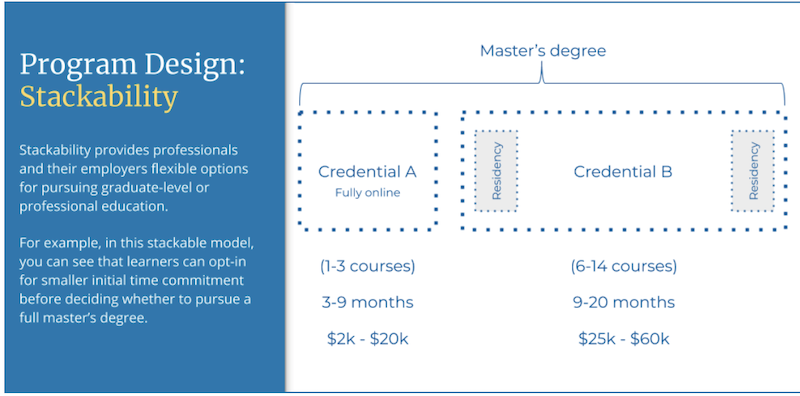Published on
The Modern Learner’s Seamless Digital Experience

Digital learning has presented the next significant growth opportunity for higher education, yet it is a growing challenge for a college or university to realize this moment’s potential. The education marketplace is increasingly crowded with competitors and offerings—from degrees to non-credit credentials. And while online learning has made it feasible for the growing market of lifelong learners to pursue more education, academic programs contend with a variety of other priorities for potential students’ time and finances.
Universities can mitigate these obstacles by designing a seamless experience for learners. Seamlessness requires reimagining educational branding and marketing, admissions, curriculum, and credentials as a singular pathway. A seamless experience begins with the learner’s personal needs or goals, continues into guided and flexible learning experiences, and culminates in meaningful outcomes for the learner.
In this post, we will look at three ways in which universities can begin to build a seamless experience for modern learners, including:
- Helping learners recognize the right learning opportunities for them
- Designing courses or programs to be flexible and user-friendly
- Providing learners with meaningful and easily shareable credentials
Empowering learners to discover the right learning opportunities
There are so many educational opportunities learners can discover. With just a bit of typing and a few clicks, a learner is introduced to dozens if not hundreds of degrees, certificates, executive education, open online courses, micro-credentials, modules, and more. The wealth of options, however, can be overwhelming, making it difficult for the learner to determine which option is right for them, given their background, goals and budget.
Universities can streamline this discovery process for learners by focusing branding and marketing on answering the following questions:
- By taking this course or program, what will you learn to do?
- How will this educational experience benefit you?
- What prerequisite knowledge or skills will you need?
- What resources will this course or program give you access to?
By using these questions to form a transparent value proposition, the university empowers learners to better identify which learning opportunity most closely fits their individual educational needs and interests.
Beyond marketing existing programs, universities also can use market research to design new curricula around the learners’ needs. At its core, market research is comprised of universities engaging in conversations with employers, alumni, and prospective students in order to learn how their institution can better meet today’s learners’ needs for scholarly expertise, critical thinking, conceptual knowledge, and skills.
Designing flexible and user-friendly learning experiences
One factor contributing to the growth of the adult learner market is the collective need for education that either advances individuals’ careers or allows adult learners to reskill for new areas of the workforce. For many adult learners, this presents the challenge of pursuing a rigorous education while also having a full-time job and limited availability, as well as facing record high tuition prices.
Credential stackability
Universities can help learners address these challenges through credential stacking: redesigning a larger credential (e.g., a degree) as multiple smaller credentials. Stack-ability decreases the upfront time and financial costs learners face, enabling some to advance their education when they would otherwise be unable to do so. In addition, as universities design each credential to provide specific knowledge and skills that pair with learners’ needs, learners can begin to realize the value of their education even while working towards earning a larger credential.

User-friendly course site design
Within programs, universities can help today’s learners by leveraging digital course platforms or learning management systems (LMSs) to redesign courses as guided learning experiences. Coupling course design best practices (e.g., the Online Learning Consortium or Quality Matters) with user experience design, universities can create a standardized course site design that consistently answers the following questions for the learner:
- Where are you in the course, and what work do you need to complete this week?
- How can you communicate with your instructors or seek help?
- What are the major program milestones you have completed, and which milestones are still ahead of you?
Redesigning course sites as similarly as scaffolded learning experiences allows learners to focus their limited time on real learning instead of re-learning course sites’ customized layouts or developing their own tools to keep track of course assignments or progress through the program.
Providing credentials that matter and are easily shareable
As universities aim to design educational offerings with a compelling value proposition based on learners’ needs, learners will be in a stronger position to communicate the value of those credentials to employers. In addition, universities can continually improve their educational offerings through market research with alumni. For example, at Duke, we have begun to survey alumni two to five years after they have completed a degree program, asking:
- What skills or actionable knowledge did you gain from your education that has benefited you most in your careers?
- How can we improve this program’s curriculum to better prepare future students for the workforce?
With this information, we can understand how well our programs meet our students’ needs as well as potential gaps between the curriculum and professional education needs in the job market.
There are also opportunities for universities to design credentials to be more easily shared. For example, requesting a university transcript can currently be a multi-step process that must be repeated whenever a learner wants to reshare their credential with someone. Educational platforms like Coursera, however, have begun to demonstrate how digital platforms can simplify credential sharing. Coursera provides a shareable URL for each learner’s credential; and the digital credential can include verification of a learner’s identity.
Bringing it all together: Aligning the design of education with the learner’s narrative
Centering education around a superior user experience can help universities attract learners to their programs and provide an education that is conducive to learners’ needs and lives. To be able to craft this experience, universities must anticipate what challenges learners will face throughout their pursuit of an education—from discovering the program to earning credentials—as well as consult both prospective students and alumni on the student experience can be improved.
Disclaimer: Embedded links in articles don’t represent author endorsement, but aim to provide readers with additional context and service
Author Perspective: Administrator



